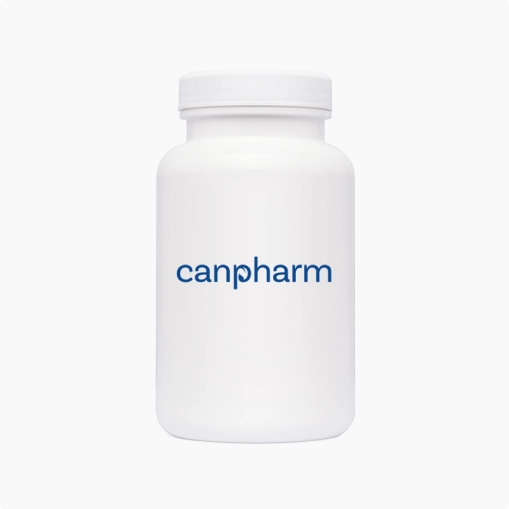
-
Description
-
Reviews (0)
-
Related Products
-
Related Conditions
Fact Table
| Fact Table | |
|---|---|
| Formula | C9H13NO3 |
| License | US FDA |
| Bioavailability | 60 to 65% |
| Legal status | US: RX Only |
| Chemical Name | Pimobendan |
| Elimination half-life | 0.4 hours |
| Dosage (Strength) | 1.25mg (50 tablets), 5mg (50 tablets) |
| Pregnancy | Consult a doctor |
| Brands | Vetmedin, Pimobendan |
| Protein binding | 90-95% |
| PubChem CID | 4823 |
| MedlinePlus | a619020 |
| ChEBI | 32003 |
| ATC code | - |
| DrugBank | DB11450 |
| KEGG | D01133 |
| Routes of administration | Oral |
Vetmedin is a prescription medication for dogs with heart disease, including congestive heart failure (CHF) and Acquired Atrioventricular Valvular Disease (AVVD). It contains pimobendane, which improves heart function by strengthening contractions and widening blood vessels, reducing strain on the heart and improving blood flow.
You can buy Vetmedin online from Canpharm, where you can get the best price for this recommended medication for treating congestive heart failure in dogs.
What is congestive heart failure (CHF) and Acquired Atrioventricular Valvular Disease (AVVD)?
Congestive heart failure (CHF) is a condition in dogs where the heart struggles to pump blood effectively. Heart problems like valve defects, cardiomyopathy, or issues with the heart muscle can cause it. Acquired Atrioventricular Valvular Disease (AAVD) is a specific heart condition that affects the valves in dogs, disrupting the normal blood flow between the heart's chambers.
Directions
One tablet of Vetmedin for dogs is given every 12 hours on an empty stomach, specifically one hour before meals. It is available in scored pills with different strengths, including 1.25 mg, 2.5 mg, 5 mg, and 10 mg. Each bottle of Vetmedin contains 50 pills. Vetmedin is also available in other forms, such as chewable tablets, hard capsules, or liquid suspension.
Ingredients
The active ingredient in Vetmedin is Pimobendan.
Cautions
Vetmedin is specifically intended for dogs aged six months or older with congestive heart failure, not for dogs with congenital heart failure.
It is important to follow the dosage instructions provided by your dog's veterinarian.
The safety of Vetmedin has not been evaluated for pregnant or nursing dogs.
Ensure that Vetmedin is kept out of reach of children to prevent accidental ingestion or misuse.
Interactions
There are currently no known risks of interactions between Vetmedin for dogs and other pet supplements or prescription medications.
Side Effects
Vetmedin chewable tablets may cause side effects in dogs, including decreased appetite, vomiting, diarrhea, weakness, changes in heart rate, and increased urination. Serious side effects are rare, but if you notice any, contact your veterinarian immediately.
Frequently Asked Questions about Vetmedin
What is Vetmedin used for in dogs?
Vetmedin is a medication used in dogs to treat congestive heart failure and dilated cardiomyopathy. It improves heart function by enhancing pumping ability and dilating blood vessels. Vetmedin alleviates symptoms and improves the quality of life.
Can Vetmedin and Furosemide be taken together?
Vetmedin and furosemide can be taken together to treat congestive heart failure in dogs. Vetmedin improves heart function, while furosemide helps remove excess fluid from the body. They are often prescribed in combination for better management of the condition.
How long does Vetmedin prolong life?
According to the VetScope study, dogs with Acquired Atrioventricular Valvular Disease (AVVD) who received Vetmedin lived for 13 months, while those on benazepril had an average lifespan of 4.5 months.
Can Vetmedin make my dog worse?
Vetmedin is generally well-tolerated by dogs, but like any medication, it can have side effects. It is rare, but some dogs may experience adverse reactions or worsening of symptoms. If you notice any concerning changes, contact your veterinarian for evaluation.
Can Vetmedin be given 2 hours after food?
If given 2 hours after food, Vetmedin will not work correctly because food can affect the absorption of the medication. It is generally recommended to administer Vetmedin on an empty stomach or at least one hour before feeding.
What happens if I give my dog too much Vetmedin?
If you accidentally give your dog too much Vetmedin, it is important to seek veterinary assistance immediately. An overdose of Vetmedin can lead to serious side effects and complications like rapid or irregular heartbeat, difficulty breathing, weakness or lethargy, loss of appetite, fainting or collapse, or seizures.
Can Vetmedin be crushed?
Crushing medications can facilitate easier administration to pets. Vetmedin chewable tablets for dogs often have a meat flavor, making it likely that your dog will consume them without any resistance. If your dog does not enjoy the taste of Vetmedin, an alternative approach is to try giving the medication with food to mask the taste and encourage consumption.
